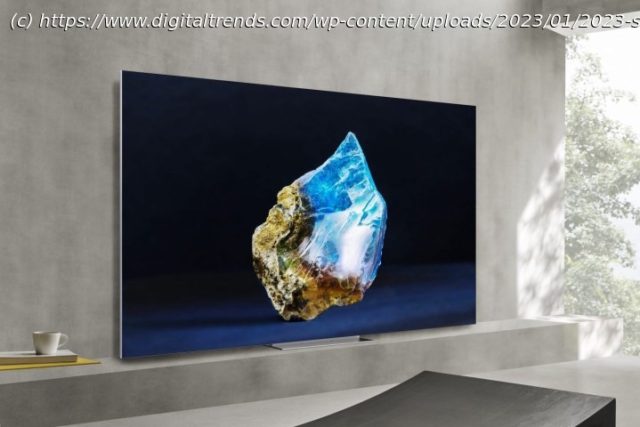Two of the most common TV acronyms out there are OLED and LED. They sound and look alike, but how are they different? We’ll show you.
If you’re shopping for a new TV, you’ve probably stumbled upon products that use OLED, LED, QLED, and even QD-OLED to describe their display. The world of electronics moves fast, and while the world was once in the throes of debating plasma vs. LCD, the game has now shifted to focus on an assortment of LED-based designs.
Trying to wrap your head around all the jargon can be challenging, especially since many of the terms look and sound nearly identical. Toss in quality disparities between brands and price tags that run from a few hundred bucks to well over $2,000, and it’s easy to get overwhelmed when looking for TVs.
Need some help on your search? Here’s everything you need to know about OLED and LED, including what the acronyms stand for, which is better, and other formats like QD-OLED and QLED.
If you’re in the market for a new TV, we’ve also rounded up the best 4K TV deals and the best OLED TV sales available.What does LED mean?
Non-OLED TVs are made of two main parts: an LCD panel and a backlight. The LCD panel contains the pixels, the little colored dots that make up a TV’s image. On their own, pixels cannot be seen; they require a backlight. When light from the backlight shines through an LCD pixel, you can see its color.
The “LED” in LED TV simply refers to how the backlight is made. In the past, a thicker and less efficient technology called CCFL (cold-cathode fluorescent light) was used. But these days, virtually every flat-screen TV (sans OLED) uses LEDs as its source of backlighting. Thus, when you see the term “LED TV,” it simply refers to an LED-backlit LCD TV.
That said, not all LED TVs are created equal. There can be differences in the number and quality of the LEDs used, which leads to differences in things like brightness and black levels. For instance, you’ve probably heard of QLED TVs. This is a type of LED TV that uses quantum dots to achieve better brightness and color. We’ll discuss QLED more below, but here’s a great overview of the differences between QLED and OLED TVs.What does OLED mean?
As mentioned, the “OLED” in OLED TV stands for “organic light-emitting diode.” OLEDs have the unusual property of being able to produce both light and color from a single diode when they’re fed electricity. Because of this, OLED TVs don’t need a separate backlight. Each pixel you see is a self-contained source of color and light.
Some of the inherent benefits of OLED screens are that they can be extremely thin and flexible. But the biggest benefit when we compare them to LED TVs is that each individual pixel receives its own luminance and power (as opposed to LED TVs, which have persistent pixels that require an external source of light to see). When it’s on, you can see it. When it’s off, it emits no light at all — it’s completely black. We’ll discuss how this affects black levels in a moment.
Currently, LG Display, famed for top-line LG OLEDs like the G3 Series, is the only manufacturer of OLED panels for TVs. And thanks to partnerships between LG Display and brands like Samsung and Sony, you’ll be able to buy Samsung and Sony OLEDs, such as the Samsung S95C and Sony A95L. While these models still use picture-processing tools developed by each respective company, the OLED panels are from LG Display.Is QLED the same as OLED?
While those pesky acronyms may sound similar, an OLED TV is not the same as a QLED TV. In fact, these two types of TVs couldn’t be more different. Remember how OLED TVs are capable of producing light and color without actual backlighting? Well, it’s exactly the opposite for QLED sets.
QLEDs are actually most similar to traditional LED-LCD TVs. The only difference is that QLEDS include a layer of quantum dots between the backlight and the display. When light passes through these chemical blots, the light source is enhanced before hitting the back of the TV screen. And by enhanced, we mean a brighter and far more colorful picture than you’d get on a non-QLED LCD screen.But what about QD-OLEDs?
Nowadays, there’s actually a picture technology that combines the best of QLED lighting and quantum dots with organic, self-emissive pixels. These TVs are called QD-OLEDs, and they’re currently made by both Samsung and Sony. Without diving into the true nitty-gritty of the picture tech, we can think of a QD-OLED as a traditional OLED infused with quantum dots. The end result of these types of displays is a TV that can achieve deep colors and contrast, as well as superior brightness.Which is better, OLED TV or LED TV?
Now it’s time to pit these two technologies against each other and see how they stack up when it comes to criteria like colors, contrast, viewing angle, brightness, and other performance considerations.
Editor’s note: Since OLED TVs are still a premium display, we have compared OLED only to equally premium LED TVs armed with similar performance potential (except, of course, in the price section).Black level
A display’s ability to produce deep, inky blacks is arguably the most important factor in achieving excellent picture quality. Deeper blacks allow for higher contrast and richer colors (among other things) and thus a more realistic and dazzling image. When it comes to black levels, OLED reigns as the undisputed champion.
LED TVs rely on LED backlights shining behind an LCD panel. Even with advanced dimming technology, which selectively dims LEDs that don’t need to be on at full blast, LED TVs have historically struggled to produce solid black levels and can suffer from an effect called “light bleed,” where lighter sections of the screen create a haze or bloom in adjacent darker areas.






